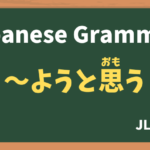
Contents
1. What is the 意向形 (Volitional Form)?
The 意向形(Volitional Form) is a verb form used to express a desire or suggestion to do something. It’s commonly used in casual conversations when saying “let’s do…” or “shall we…?”. It’s also used when expressing intentions, such as “I’ll do this” or “I plan to…”. This form is an essential part of everyday Japanese.
2. How to Form the 意向形 for Each Verb Group
There are two main ways to create the volitional form, based on whether you’re starting from the dictionary form or the ます form.
Method 1: Forming the Volitional Form from the Dictionary Form (e.g., のむ)
For learners familiar with the dictionary form, here’s how to conjugate each verb group into the volitional form:
- Group 1 (U-Verbs):
- Change the final "u" sound to "ou" (おう).
- Examples:
- のむ → のもう (let’s drink)
- かく → かこう (let’s write)
- はなす → はなそう (let’s speak)
- Group 2 (RU-Verbs):
- Remove る and add よう.
- Examples:
- たべる → たべよう (let’s eat)
- みる → みよう (let’s see)
- Group 3 (Irregular Verbs):
- する becomes しよう (let’s do).
- くる becomes こよう (let’s come).
Method 2: Forming the Volitional Form from the ます Form (e.g., のみます)
For learners who studied the ます form first, here’s how to create the volitional form based on it:
- Group 1 (U-Verbs):
- If the verb ends in 〜い before ます: Change い to おう.
- Examples:
- のみます → のもう (let’s drink)
- かきます → かこう (let’s write)
- はなします → はなそう (let’s speak)
- Group 2 (RU-Verbs):
- Remove ます and add よう.
- Examples:
- たべます → たべよう (let’s eat)
- みます → みよう (let’s see)
- Group 3 (Irregular Verbs):
- します becomes しよう (let’s do).
- きます becomes こよう (let’s come).
This approach makes it easy for learners who are familiar with the ます form to conjugate into the volitional form.
4. Sample Sentences
Here are some example sentences to help you see how the volitional form is used in context.
- Group 1 (U-Verbs):
- のむ (to drink) → のもう: ジュースを のもう!
(Let’s drink juice!) - かく (to write) → かこう: にっきを かこう。
(Let’s write a journal.)
- のむ (to drink) → のもう: ジュースを のもう!
- Group 2 (RU-Verbs):
- たべる (to eat) → たべよう: いっしょに ごはんを たべよう。
(Let’s eat together.) - みる (to see) → みよう: あたらしい えいがを みよう!
(Let’s watch the new movie!)
- たべる (to eat) → たべよう: いっしょに ごはんを たべよう。
- Group 3 (Irregular Verbs):
- する (to do) → しよう: しゅくだいを しよう。
(Let’s do our homework.) - くる (to come) → こよう: あしたは はやく こよう。
(Let’s come early tomorrow.)
- する (to do) → しよう: しゅくだいを しよう。
5. Common Uses of the Volitional Form
The volitional form has a variety of uses in Japanese. Here are a few common examples:
- Suggesting an Action Together:
The volitional form is often used to suggest doing something together, much like "let’s" in English.- Example: いっしょに べんきょうしよう。 (Let’s study together.)
- Expressing One’s Own Intention or Decision:
The volitional form can also express a decision or intent, such as "I’ll do this."- Example: あしたは はやく おきよう。 (I’ll wake up early tomorrow.)
- Used with と思う to Indicate Planning or Thinking:
When combined with と思う, the volitional form shows intention or a plan.- Example: にほんに いこうと おもう。 (I’m thinking of going to Japan.)
This structure is especially helpful when talking about future plans or intentions in a conversational tone.








